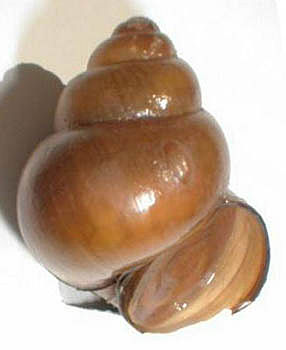
While on a Three Rivers Birding Club outing at Moraine State Park on March 20, several of us found snail shells like this one at the Old Rt.422 dock at Lake Arthur.
Some of the shells were large (2″ long). All of them were empty.
I’d never seen a snail this big in Pennsylvania and its identity was a mystery but I knew who could solve it. I emailed a description to Tim Pearce, head of the Section of Mollusks at the Carnegie Museum of Natural History. Even though I’d sent no photo, Tim told me what it was and suggested that I google Cipangopaludina chinensis to see if the photo matched my snail. Sure enough, it did.
Cipangopaludina chinensis, commonly known as the Chinese Mystery snail, is native to Southeast Asia, China, Japan and eastern Russia. Its shell looks like a turban and it can grow to 2.5″ long. If I’d found a live snail I would have been amazed by its operculum, the trap door that completely covers the shell opening when the animal retreats inside. In the photo above, the snail has closed his operculum.
How did so many of these snails get into Lake Arthur?
Chinese mystery snails came to North America as food and aquarium species. They’re popular in aquariums because they don’t eat fish eggs. Their first introduction to the wilds of North America was probably between 1932 and 1941 through a release from someone’s aquarium (i.e. dumping) into the Niagara River. Since then mystery snails have spread to the Great Lakes, the northeastern U.S. and random watersheds elsewhere (more dumping).
According to the USGS website, Cipangopaludina chinensis prefers slow moving freshwater rivers, streams and lakes with soft muddy or silty bottoms. That pretty much describes Lake Arthur and, though the USGS range map doesn’t show mystery snails in this part of the state, it’s easy to guess how they got here.
Fortunately Chinese mystery snails are considered benign because they haven’t harmed native species… yet.
So now you know. If you find a snail like this you can tell your friends it’s a mystery.
(photo from Wikimedia Commons. Click on the photo to see the original)
Not snail related, but for all of us from around pittsburgh, thought I’d share today’s groupon for bird stuff if Kate doesn’t mind. You can get $30 of bird feed and other things for only $15 from a few local stores. Never been there, don’t have a lawn in which I can set up a feeder. Hopefully some of you might be able to make use of it though! Maybe help fatten up our local peregrine menu choices? http://www.groupon.com/r/uu8488528
I had seen these snails in the lake at Keystone State Park many years ago, maybe a dozen. I don’t know if they are still there. Thanks for supplying an explaination.
Not sure, but a few years ago while walking/birding along the Red Mill section of a trail above Indiana, Margaret, Mary Ann, and I came across a lovely shell but with the snail in it, in a dangerous location for the snail–right in the middle of the rocky trail. I would say it was about 2″ but perhaps not quite as cone-shaped. Same coloring however and circular. Another interesting part of nature. Thanks for sharing this Kate.
I was doing a search on these snails and came across your blog. My husband and I found very large snails in Hinkston(sp?) Run Dam near Johnstown. After doing some research determined that they are in fact the Chinese mystery snail. We are going to try to eat them. I will come back and let you know how it went.
Do let me know what they’re like. I never thought of eating them, but I’m not fond of “escargot.”
UPDATE… Before eating them, read the ecology section here:
http://nas.er.usgs.gov/queries/factsheet.aspx?SpeciesID=1045
These snails are still thriving in keystone lake as of 7/14/2021